This time, we will focus on power supply accuracy.
After you design the power supply to the FPGA/CPLD, you will pick up the completed board and check with the actual device whether the power supply is output as designed. At that time, I don't think it's possible to observe the voltage exactly as designed.
- Well, it can't be helped even if it's slightly off. But how far can you go?
- What are the specifications on the FPGA side?
- What are the specifications on the power supply side?
This time, I would like to answer such a question.
What is power supply accuracy?
For example, suppose the output of the power supply IC was 1.1V. Even if it is designed to be 1.1V, it is unlikely that the value is exactly 1.1V when measured with an actual device. It may be 1.0V, it may be 1.2V. Although it depends on the specifications of the power supply IC, the index of output voltage within what percentage, including individual differences, is called accuracy. FPGAs have recommended conditions for the accuracy of the supply voltage for each power supply line.
From now on, I will use the Cyclone® V FPGA as an example to proceed with the discussion. First, let's check how much accuracy is required for the core power supply.
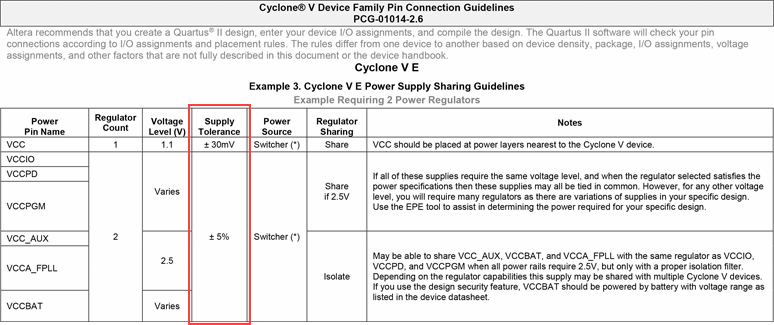
The figure above is an excerpt of the Cyclone® V FPGA pin connection guidelines. The required voltage for each power line is listed in the Voltage Level (V) column. Furthermore, the accuracy required there is written in the Supply Tolerance column. It can be seen that the VCC (core supply) of the Cyclone® V FPGA is ±30mV and the others require a ±5% accuracy power supply. ±5% is fine, but ±30mV seems quite strict. For example, can EN5311, which is often used in 1A products, be able to be within ±30mV?
Consider the following elements in order, one by one. First of all, the required accuracy of VCC for Cyclone® V FPGA is 1.1V±30mV, so I summarized it in the figure below.
Pin connection guidelines for other devices
DEVICE PIN CONNECTION GUIDELINES
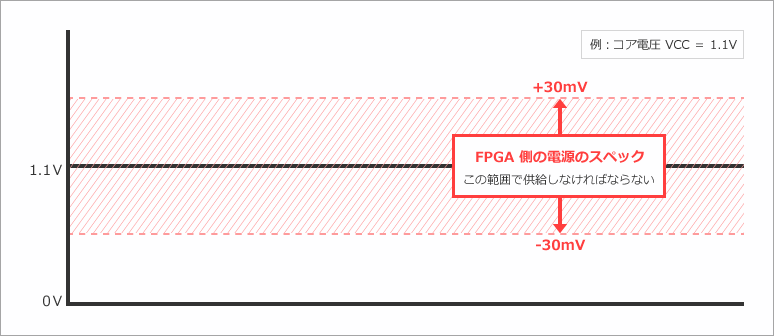
Now that we know the required precision of the FPGA, we next check whether the output of the power supply IC is within this specified value.
How do you check the accuracy of a power supply IC? (VID mode)
I checked the EN5311 datasheet and found the following table:
| PARAMETER | SYMBOL | TEST CONDITIONS | MIN | TYP | MAX | UNITS |
| Vout Initial Accuracy (VID) |
Vout | 2.4V ≤ Vin ≤ 5.5V, Iload = 100mA; Ta = 25°C |
-2.0 | - | +2.0 | % |
| Vout Variation for all Causes (VID) |
Vout | 2.4V ≤ Vin ≤ 5.5V, Iload = 0-1A, Ta = -40°C to +85°C |
-3.0 | - | +3.0 | % |
| Feedback Pin Voltage | Vfb | 2.4V ≤ Vin ≤ 6.6V, Iload = 100mA Ta = 25°C; VSO = VS1 = VS2 = 1 |
0.591 | 0.603 | 0.615 | V |
| Feedback Pin Voltage | Vfb | 2.4V ≤ Vin ≤ 6.6V, Iload = 0-1A, Ta = -40°C to +85°C; VSO=VS1=VS2=1 |
0.585 | 0.603 | 0.621 | V |
There are two descriptions of Vout and Vfb in the Symbol column. Vout is the EN5311 output accuracy in VID mode and Vfb is the output accuracy in Vfb mode. There are two types of descriptions for each of Vout / Vfb. The difference is the Test Condition. First, consider the difference in VID mode.
For ±2% accuracy: Ta = 25°C / Iload = 100mA
For ±3% accuracy: -40°C < Ta < 80°C / 0A < Iload < 1A
Ta is the ambient temperature of the device and Iload is the output current. As you can see, the Test Condition is quite restrictive when the accuracy is good. Considering the operation of the actual device, it is more realistic to consider the case where the test conditions are -40°C < Ta < 80°C / 0A < Iload < 1A. Therefore, when checking the accuracy of a power supply, it is necessary to be aware of what the guaranteed accuracy is in any state within the range of recommended conditions.
Also take a look at Vfb (Vfb mode).
For ±2% accuracy: Ta = 25°C / Iload = 100mA
For ±3% accuracy: -40°C < Ta < 80°C / 0A < Iload < 1A
The concept of Vfb is basically the same as that of Vout. Please refer to Test Condition -40℃ < Ta < 80℃ / 0A < Iload < 1A. Therefore, consider ±3% when considering actual operation. However, Vfb mode does not end there. There are other elements that must be considered, but for the time being, the image so far is illustrated below.
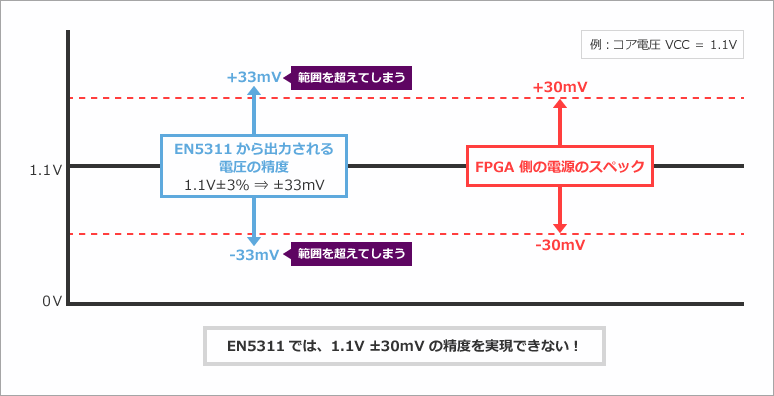
that? Considering the accuracy of ±3%, it exceeds ±30mV. This cannot satisfy the required precision of FPGA. In fact, all Enpirion® series beginning with EN53** or EP53** have ±3% accuracy, so they cannot be used with power lines that require 1.1V±30mV. Therefore, we do not recommend EN53**/EP53** if this level of accuracy is required for core and transceiver power supplies, such as Cyclone® V FPGAs.
So what about the ±5% accuracy power supplies mentioned above? For example, if the power supply for IO is 2.5V, the required accuracy is ±5%, so Max: 2.625V/Min: 2.375V. The figure is as follows. After adding the ±3% accuracy of EN53**, it was found to be within ±125mV, which is ±5%, which is the required accuracy of Cyclone® V FPGA.
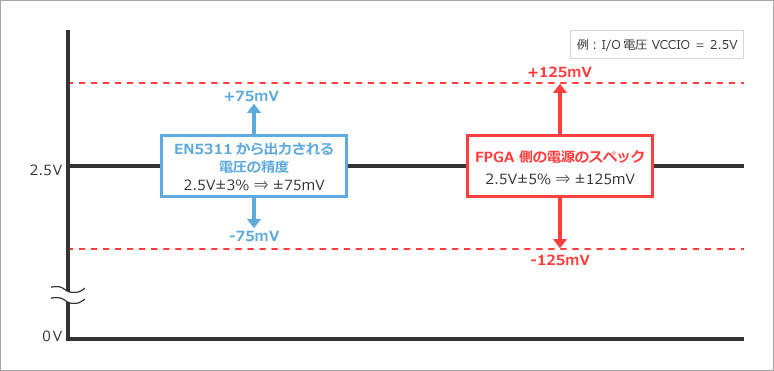
What else should I check?
Once you have confirmed that the power supply accuracy is within the FPGA's required specifications, the next step is to check the power supply ripple in the datasheet. I checked the EN5311 datasheet and found the following information:
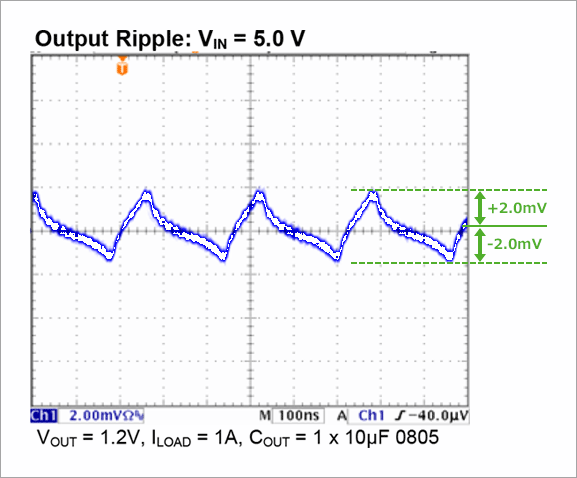
Since it is 5Vin/ 1.2Vout, it is different from the target this time, but I will refer to this value for now. It looks like ±2mV, so add this to the previous accuracy and see if it satisfies the FPGA's required specifications.
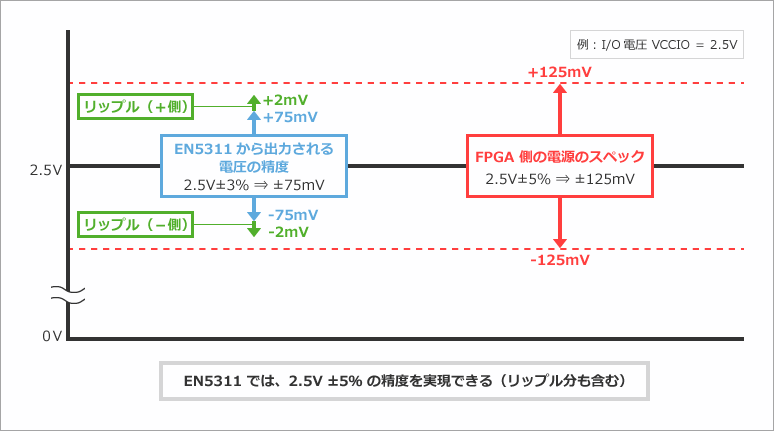
When I checked it, I found that it was ±77mV. The FPGA requirement is ±125mV, so we know we meet the requirement. We found that EN5311 can be used if the required accuracy is ±5%. For ±5% accuracy requirements, consider EN5311. However, if more than 1A of current is required, please consider another series starting with EN53. We also have a line of devices that meet the requirements for ±5% accuracy.
How was it?
- How do I find out the accuracy of the power supply I need for my FPGA?
- How do you choose a power supply to fit in there?
- How exactly should it be calculated?
I hope you understand. Furthermore, Enpirion®'s EN53** series has ±3% accuracy, so we found that it is ideal for power supply lines that require accuracy within ±5% for FPGA IO and PLL power supplies.
"What is power supply accuracy? (Part 2)”, I would like to touch on Enpirion® devices that correspond to FPGA cores and transceivers.
Click here for recommended articles/materials
<Intel®Enpirion®Power Solutions>
What are the power supply elements required for FPGAs?
What is the power consumption of FPGA?
What is power supply accuracy? (Part 1)
What is power supply accuracy? (Part 2)
Intel® FPGA Development Flow/Top Page

